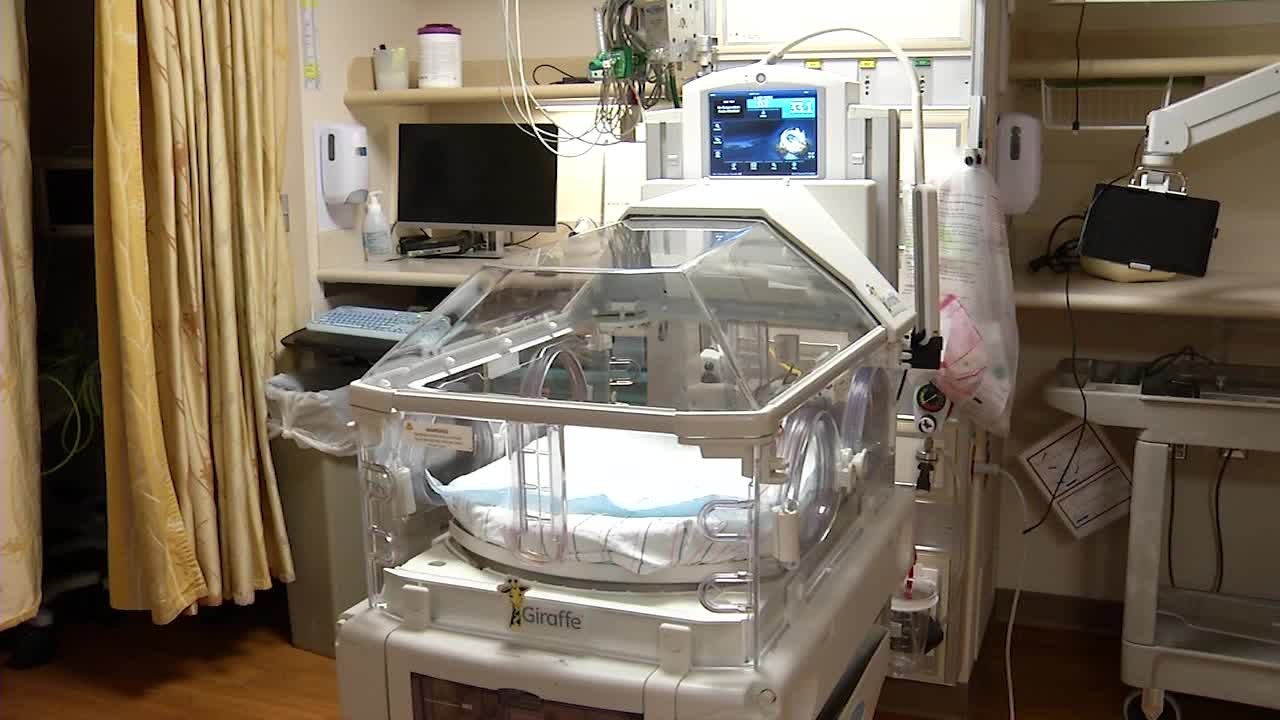Tele-NICU program helps physicians safely deliver babies across Minnesota
[anvplayer video=”5161567″ station=”998122″]
A new program is helping physicians safely deliver more babies across Minnesota. M Health Fairview launched its Tele-NICU program at Ridges Hospital in June and it’s been expanding to other facilities.
It allows doctors at M Health Fairview Masonic Children’s Hospital to connect virtually to delivery rooms across the state. A high-definition camera brings them into the room with a physician at a remote location who requests assistance.
“We can help walk them through the next steps that need to happen and hopefully anticipate some of the challenges that might be coming down the pipeline if we were able to see they weren’t able to respond to those treatments,” said Dr. Ellen Diego, a neonatologist for M Health Fairview.
In December, Jessie Johnson experienced the benefits of this technology first-hand.
She had a cesarean section scheduled for Jan. 25 at a hospital in Duluth, which was more than an hour from their Hill City home but equipped to handle her high-risk pregnancy.

Eight years ago, Johnson was diagnosed with a benign pituitary tumor. She had three surgeries and was the first Mayo Clinic patient to undergo a targeted radiation treatment called proton beam therapy. At the time, her neurosurgeon told her it might not be possible to become a mother.
She later married Adam Johnson and during the pandemic underwent years of IVF, which finally resulted in her pregnancy.
On Dec. 13, Johnson went into labor at about seven and a half months pregnant. They rushed to nearby Grand Itasca Clinic and Hospital as snowflakes started to fall.
“I was working in one of our after-hours clinics and I got a phone call from our OB that we had someone here in labor who had a really complicated pregnancy,” said Dr. Tim Pehl, a family physician at Grand Itasca.
A snow storm made her delivery even more complicated.
“We weren’t going to be able to transfer this woman to Duluth, where we’d normally transfer her,” said Dr. Pehl. “The helicopters weren’t flying anywhere so the NICU team was coming by ground transport in an ambulance so that was going to take several hours.”
“I was a little nervous to deliver at Grand Itasca, one with my medical condition and then also with him because they didn’t have the NICU set up,” Johnson remembers.
Six weeks earlier, the hospital received Tele-NICU training. Dr. Pehl explained they called Masonic Children’s Hospital and asked for help with Johnson’s case.
“They were prepping the mom to be able to deliver the baby,” said Dr. Diego, who picked up the call. “We just had a couple of minutes to kind of prep the team and make some calls to get the medical crew who would hopefully be able to come pick up [the baby] in the event that he needed to be transferred to another facility.”
She was able to monitor newborn baby Teddy’s vitals from the Twin Cities office. The technology allows physicians to pan the camera around the room and zoom in on the patient, monitors, or family members in the room.
“We can assess the baby and really see what these providers are seeing at these outside facilities,” said Dr. Diego. “We might be helping with thermoregulation, helping keep their temperature up. We might be helping with their breathing, we might be helping walk them through how to support their cardiac function, how to support their heart, all of the other organ systems in their body.”
One of the biggest concerns with premature babies is often their breathing.
“If we have to put a breathing tube in an infant she can read the numbers of the breathing tube and say ‘Woah that looks like it’s in too far’ or ‘That looks like it’s not in enough’,” said Dr. Pehl. “It’s kind of an all hands on deck approach.”
Fortunately, Teddy was born healthy and didn’t need a breathing tube.
“I could hear the Tele-NICU people saying ‘He’s breathing, he’s warm and he’s doing all of this stuff’,” said Adam Johnson. “It was pretty reassuring to hear what they were doing.”
The Tele-NICU program is available 24/7 and it’s meeting an increased need.
“In rural Minnesota, a lot of small town hospitals have stopped delivering babies and we’re sort of a small-medium town hospital so we’re delivering more babies,” said Dr. Pehl. “We’re far enough from a NICU that we’ve always known that there are scenarios when we have to do the best we can and rely on our training the best we can and hope there’s a good outcome but now having a neonatologist in the room virtually just is a complete game changer.”
“When we can visually be inside of a delivery room and see what the providers are seeing who are in some of these facilities that might be in an area we can’t get to, that is potentially life-changing for those patients,” Dr. Diego added.
The medical transport finally arrived at Grand Itasca three hours after Teddy was born. He was brought to a Duluth hospital where he was in the NICU before heading home just before New Year’s Day.
“Without the tele-NICU, I don’t know where we would’ve been on that night,” said Adam Johnson. “I was just grateful that they have this not only for us at the time but for others in the future.”